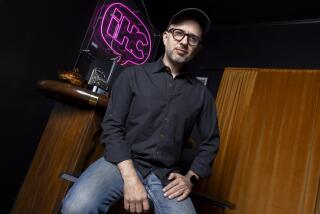Slain Teen Had Found His Niche in Dancing : Youth: Carl Dan Claes, 14, was part of a re-emerging interest in break-dancing, the ‘80s precursor to hip-hop.
- Share via
ORANGE — Many adolescents seek acceptance and identity in a youth subculture. Carl Dan Claes--the Tustin 14-year-old fatally shot two weeks ago, apparently over a stereo system--had found his niche in the revival of break-dancing.
The celebrated craze of the late ‘70s and early ‘80s has resurfaced along with the fashion, music and lingo of “old school,” a popular phrase referring to the early era of hip-hop.
A February event in Los Angeles called the Radiotron Show, named after one of the original clubs, drew hundreds of fans--many not even born the first time break-dancing hit. Urb magazine, the bible of club culture, followed that event with a feature this month on break-dancing’s return.
Claes reportedly knew other teens who shared his interest in break-dancing, even though they didn’t go to A.G. Currie Middle School with him. He had friends in a break-dancing crew--a group that forms to compete through dancing against other crews--but it is unclear if he was a member, according to a sheriff’s homicide investigator.
Among Claes’ other associations in this scene apparently were the three youths accused of involvement in the slaying. Claes’ body was found in a ditch May 17 three miles from his Tustin home. Authorities said Claes lent the suspects a six-foot console about a week before he was slain.
Claes’ grandfather gave him the $2,500 mobile sound system in April, encouraging the teen to practice his dance moves and deejay skills at home where he could be supervised.
While the latest wave of break-dancing is still generally considered underground and performed mostly at house parties, enthusiasts tend to head for one of the local nonalcoholic nightclubs catering to minors such as Bounce in Irvine, the Sound Factory in Orange and the Coalition in Fullerton.
Its rebirth has managed to find plenty of fans among preteens and teens who have learned about it from older siblings and cousins or by renting such decade-old movies as “Back Street” or “Breakin’.”
Apparel companies have responded by bringing back vintage designs of sneakers, hats and clothing favored by first-generation hip-hoppers. Teens scavenge thrift stores and their relatives’ closets for old side-striped gym wear, cheerleading skirts and V-neck soccer shirts.
Kris Plourde, the 20-year-old co-promoter of Bounce, said, “You can’t bring back Adidas gym suits, suede Puma sneakers and vintage hip-hop and not have break dancing.”
At age 20, Bounce regular Dave Frazier is considered a veteran at the Irvine club. “Within the last year-and-a-half it’s become a trendy thing to do again,” said Frazier of Westminster, a member of the Morlock dance crew.
Frazier said he knows of at least a dozen county-based dance crews, their members mixing breaking and hip-hop styles. While the scene crosses ethnic lines, it counts few girls. Most enthusiasts are “guys from 8 years old to their late 20s,” he said.
“It’s more of an underage thing,” said Plourde, who expressed sadness over the death of Claes. “These kids practice all week long just to show it off on the weekends. I think it’s pretty positive that they can spend so much of their time at this and do battle on the floor.”
Enthusiasts prefer to play out rivalry challenges through dancing instead of violence. Flare-ups can occasionally escalate into shoving or verbal exchanges, but Plourde and other club promoters insisted such incidents are not tolerated and swiftly diffused.
“We try to keep the competition on a peaceful level,” Plourde said.
Loara High School freshman Amier Ramezani agreed. “It’s better than fighting,” he said. The 15-year-old from Anaheim can apparently do it all--head spins, side twists, windmills on his back.
His agile body contorts and jerks and hits the ground with impressive control. He prefers flying his feet solo to joining a dance crew, but meets up with fellow dancers at Sound Factory, the Fridays-only event at the Tunnel nightclub in Orange.
The place bears all the trappings of an illegal underground in so far as location in an industrial park, its unlisted phone number, the spray-painted sign, the ugly, discarded couches and bean bags and a light and sound system that bombards the senses.
But the Tunnel complies with city regulations, has a full security staff and serves caffe lattes and Slushees. It’s like a school dance, but hipper.
Every weekend, several hundred teens from around the county gather in the legally held warehouse party where deejays spin the latest house music.
While break-dancers prefer hip-hop music, they make do where and when they have to. In Claes’ case, his grandfather tried to accommodate his passion with a couple of turntables and a strobe light.
More to Read
Sign up for Essential California
The most important California stories and recommendations in your inbox every morning.
You may occasionally receive promotional content from the Los Angeles Times.












![Vista, California-Apri 2, 2025-Hours after undergoing dental surgery a 9-year-old girl was found unresponsive in her home, officials are investigating what caused her death. On March 18, Silvanna Moreno was placed under anesthesia for a dental surgery at Dreamtime Dentistry, a dental facility that "strive[s] to be the premier office for sedation dentistry in Vitsa, CA. (Google Maps)](https://ca-times.brightspotcdn.com/dims4/default/07a58b2/2147483647/strip/true/crop/2016x1344+29+0/resize/840x560!/quality/75/?url=https%3A%2F%2Fcalifornia-times-brightspot.s3.amazonaws.com%2F78%2Ffd%2F9bbf9b62489fa209f9c67df2e472%2Fla-me-dreamtime-dentist-01.jpg)
